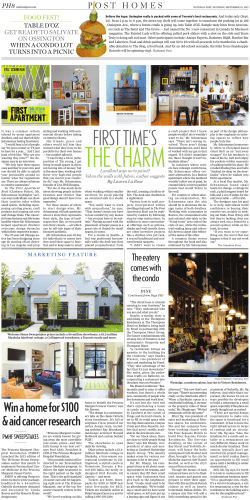
Yum! Brands Symbol: YUM Jiawei Chen & Tianran Chen March 31 2009
Yum! Brands Symbol: YUM Jiawei Chen & Tianran Chen Revised by: Ryan Comisky March 31 2009 Agenda Industry overview Company overview Competitors Thesis points 1. Global 2. Management 3. Cash flow advantage Financial Data Risk factors Industry overview U.S: 945,000 restaurants $552 billion in annual sales. Quick Service Restaurants (QSR) consist of 72.8 % of the whole industry revenues. Advantage of economies of scalelow priced value meals Fierce competition Company Overview World’s largest quick service restaurant (“QSR”) company based on number of system units 1997 spin-off of PepsiCo forms Tricon 2002 changed its name from TRICON Global Restaurants, Inc. to YUM! Brands, Inc. Five concepts KFC: chicken. Pizza Hut : quick-service pizza Taco Bell: Mexican-style food LJS: seafood categories A&W Business structure * Company-operating units * Independent franchisees or licensees Units Distribution 3 segments: 1. United States - 20,000 units 2. YUM Restaurants International (YRI) – 13,000 units 3. China – 3,600 units More than 36,300 units in more than 110 countries and territories Competitor McDonald’s Domino’s Pizza Burger King Thesis points 1) Global distribution system which has great potential 2) Strong management team and energetic company culture 3) Strong cash flow Thesis I: Strong overseas growth potential world-wide revenue distribution (unit: million) 2008 2007 2006 US $4410 4518 4952 YRI $2375 2507 1826 China $2058 2075 1587 The China Division and YRI have been experiencing dramatic growth and now represent nearly 60% of the Company’s operating profits I. Global Development---Rapid Growth in China Mainland China -rapidly growing economy -population of 1.3 billion KFC -Leading QSR 2500 units in 500 cities -Yum! opens nearly one new KFC every day in mainland China (Q4 2008) Pizza Hut -Western-style casual dining restaurants -400 in 100 cities -the first restaurant chain to introduce pizza Long Term GOAL at least 20,000 units in mainland China. China division system sales growth 2008 2007 31% 31% 2006 26% 2005 13% SO, why is Yum! successful? Competitive advantages: 1. Food Quality and Flavor! 2. Product Strategy: localization -Foreign brand with Chinese Character -Promote new product every months -Combine Chinese dining tradition 3. Marketing the Brand - Make restaurant a social communication place - Modern lifestyle behind the food Not a Coincidence!! Survey Q: Why do you go to KFC or Pizza Hut? A: Food Flavor and Quality: 85% Eating Environment: 43.6% Convenience: 38.2% Price: 25.5% Follow trend or advertisement: 0% Manager telephone interview Q: In your opinion, what is the main reason that Yum! Brands can be successful in China? A: 1. Quality 2. Food Flavor 3. Service: targeted to different age populations - Birthday party - Student discount Can the success continue in the future? -Yes! 1. Low individual visiting frequency for existing customers consistent and stable consumption pattern Survey Q: How often do you eat in these restaurants? KFC Occasionally: 57.4% Pizza Hut Occasionally: 83.3% 2. Large Potential Market for Lower Income Population Survey Q: How much do you spend on average every time you go to KFC? A: 15-25 RMB—2.2-3.6 Dollar 56% 25-50 RMB—3.6-7.1 Dollar 36.4% Pizza Hut? 30-50 RMB—4.3-7.1 Dollar 34.5% 50-80 RMB—7.2-11.4 Dollar 34.5% Survey Q: If there is an economic crisis, how will it influence your consumption in these restaurant? No Change: 55.6% Both decrease: 27.8% Decrease in Pizza Hut, no change in KFC: 13% What’s more……. New Brand, New Product Pizza Hut Home Service (pizza delivery) East Dawning (Chinese food) 20% shares of Little Sheep Company, a Chinese Hotpot system restaurant Joining Hotpot II. Overseas--International YRI Revenues: $3.0 billion Operating Profit: $528 million (2008) 9 straight years of opening over 700 new restaurants. Company expects to continue to experience strong growth in new markets, including India, France, and Russia. Increase of Percentage In Franchise Fees Around The Globe (in 2008) Asia (excluding China) 19% Latin America 12% Middle East Northern America 32% South Africa 32% India Interview Indian students at UVa - Develop in recent years - Localization of food, offer vegetarian options - Welcomed by young people - Large growing potential USA Highly competitive marketplace Slower profit growth But continues to produce strong cash flows. Furthermore . . . Multibranding, should strengthen volume sales Refranchising company-owned restaurants. By the end of 2010, management hopes to own less than 10% of its U.S. restaurants (down from 20%)More cash flow Thesis II. Management Core CHAMPS – Cleanliness, Hospitality, Accuracy, Maintenance, Product Quality and Speed of Service Various senior operators visit the company’s restaurants from time to time to help ensure adherence to system standards and mentor restaurant team members. VAR about Management - “Challenging” - “Systematic” - “Like a family” Thesis III: Strong Cash Flows In 2009, it is important to note that management does not need to access the credit markets to finance their company Strong cash flow and balance sheet provide them with the flexibility to successfully navigate through these challenging financial times. 3 Year Cash Flow Breakdown 2008 2007 2006 Cash flow by operating 1521 activities Repayments of long(268) term debt 1551 1257 Capital spending (935) (726) (572) Cash and Cash Equivalents $216 $789 $319 (24) (211) Financial Data Last Trade:27.65 Market Cap(bil) 12.68B P/E 14.5 EPS (ttm):1.96 P/S Ratio 1.09 5-Y Avg Ann Return 6.91% Annual Dividend $0.76 Dividend Yield 2.6% Beta 1.09 the cumulative total return 2008 Highlights · Worldwide system sales growth of 7% - same store sales growth of 3%+ international development of 1,495 new units · Worldwide operating profit growth of 8% • An industry leader with return on invested capital (ROIC) of 20%. Earnings per share (EPS) for the previous four quarters: $1.90 Worldwide Operating Profit growth: 11% PE ratio: 14 Stock price declines compared to 2008 2006 has the same stock price Risk Factors Operating results are closely tied to the success of the Concepts’ franchisees. Nature and volatility of the foreign currency markets Influence by commodity price Risk, but also OPPORTUNITY! Foreign currency factor can be a great advantage for Yum! Brands US Dollar depreciation relative to RMB more of an opportunity than risk Questions?
© Copyright 2025





















